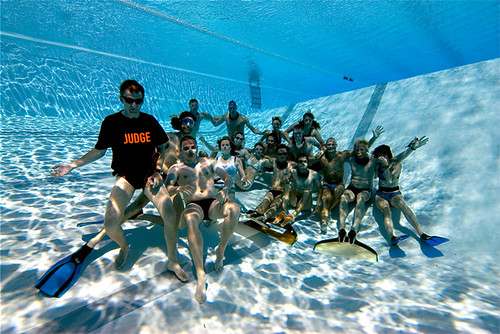When I was in Lysekil I participating in the first real life test of a counter ballast system (CBS) and it became clear to me that we will need more of these tests in order to gather more information and gain a better understanding of how these things work.
As I have been building a CBS on my own for the competition in Wildschütz I was even more curious (and a little nervous) about the outcome of this test. The set up is quite like in Lysekil. We drop the bottom plate to -40m. Wolle is going down with a lanyard around his waist. He is wearing no fins.
50 seconds after he dived in I feel a pull on the rope, the signal for the release of the CBS. As the counter ballast is being dropped on the other side of the platform I am watching the rope fall into the green water and wait for the first pull up. The weight on the bottom plate is 15 kg the counter ballast is 30 kg. Two men are pulling the rope on the platform to increase speed.
I am diving in to observe the scene while the safety divers are going for Wolle. When I see him he looks very calm and relaxed just like Stig did on the first test hanging on the rope. Only at the second glance I see that he is actually holding on to the lanyard with one hand.
Later Wolle told me that the waist belt holding the lanyard was too thin. He feared that it would break and that is why he grabbed the lanyards end. So it is necessary not only to check the lanyard but also the way it is attached to the body. That was the problem in Lysekil as well.
1’04 after we released the CBS Wolles head pops out of the water. Total dive time 1’54. That means we took 64 seconds to pull up a diver from 40 meters of depth. Is that too slow? I was hoping to end up at 1 m/s but that was not possible here.
On the first day when I tested the CBS with no diver attached I had the impression everything was running much smoother. Now, after the rope was in the water over night it must have been swelling and that caused friction on the rear pulley.
The next day we put some extra weight on the counter ballast. Whether that would help to speed up the process of retrieval I do not know. As Sebastian said, more speed can also create more problems. 40 m is a relatively shallow depth in regards to what the athletes where diving that day. Greater depth means longer dives, means longer before you know something went wrong, means longer before you act and longer before you have the person out of the water.
Maybe the answer is to release the CBS after 60 % of the estimated dive time and bring it up until the diver surfaced. Maybe this is all just overrated and I am thinking too much about the unlikeliest of events.
Ideas, comments, thoughts? Please share them with me.
vor 8 Jahren






I also feel that the time of the retrival of a blacked out diver is very important. We need to find ways to improve this.
AntwortenLöschenOne of the things that Sebastian was trying to do in Lysekil, which I mean is a good idea, was monitoring the diver during the whole dive by a depth sonar. It didn't work out perfectly I think, but if it would, that would increase safety alot. Especially for deep dives in dark and murky water...
Yes, the idea with the fish finder is very tempting. A lot of problems would go away when you could monitor the diver like this.
AntwortenLöschenWe tested it and had to find out that the thermo cline and the accompanying algae make it only possible to monitor until the diver disappears into that layer. So we could "see" down to 15 - 20 m. That is not reliable and not giving and advantage at all... :(